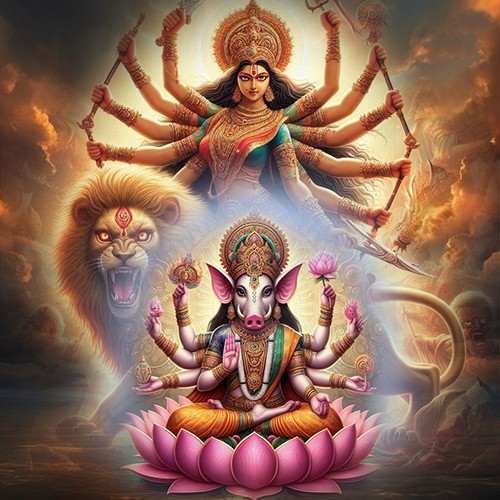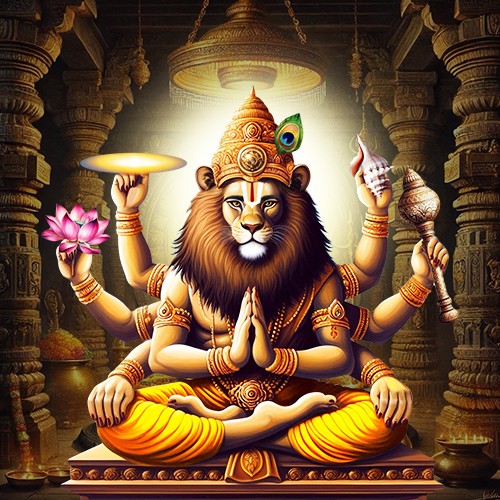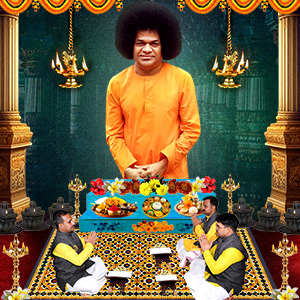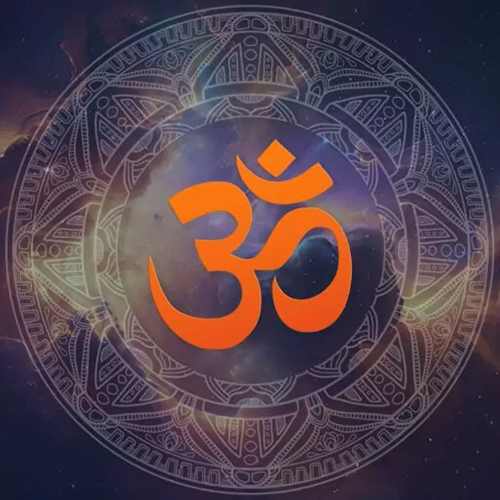Lokapala - Guardians of the Direction in Hindu
Indian mythology is packed with a rich history, captivating characters and relatable stories that resonate. Several of the mythologies could have undergone several retellings over the years. It is home to enthralling epics such as Ramayana and Mahabharata, the latter being the longest known epic in history.
Hinduism is known for its many deities, some with incredible and exceptional powers. The majority of the Hindus concentrate on one of these, whom they consider as supreme. The greatest Gods and Goddesses possess complex traits that are showcased in diverse forms, situations and narratives. They are occasionally accompanied by their spouses or their specific animal vehicles. They are frequently recognized by their physical attributes and the symbolic implements they wear or hold.
There are numerous Hindu deities that are used and observed in various contexts of Indian mythology. Referred to as the guardian of the world, Lokapala has different uses, contingent on whether it is viewed in a Hindu or Buddhist setting.
Who is Lokapala?
In Hindu Dharma, Lokapala is believed to be the guardian of the four cardinal directions. The Lokapalas are labeled as the regents of the east, south, west and north. Also referred to as the Dikpalas, the four main guardians and protectors who ride elephants are Kubera (North), Yama (South), Indra (East) and Varuna (West). Each of the guardian Gods comes with an elephant as they partake in protecting the occupants of the respective direction they are presiding over. The elephants themselves are also called Lokapalas.
Let us look at each of them in detail:
Kubera:
He is the deity allied to the northern direction and is considered the Lord of Wealth. He is frequently showcased as someone who is decked with various jewels, is overweight and has a winged conch shell. His mount is sometimes meant to be a human man or a horse. He is believed to be the treasurer of Goddess Lakshmi, who is known for good fortune, prosperity and success. As a Lokapala, Lord Kubera is portrayed riding an elephant known as Sarvahbauma.
Indra:
The Lokapala related to the Eastern direction is Lord Indra. He is meant to be the God of Rain and Thunder. The deity is usually portrayed as riding a white elephant while holding a lightning bolt known as the vajra. As the head of the devas (Gods), he is considered to always be waging a battle on the asuras (demons). Lord Indra stands for the eastern direction of Hindu temples. As a Lokapala, he rides an elephant called Airavata.
Yam:
He is known for being the God of Death or the Underworld. He denotes the southern direction of the Hindu shrines. He is believed to be the first mortal who died and became the king of the underworld. Lord Yama is regarded as the deity who signifies the element of fire and can be found over the southern area of the temple. He is commonly showcased as riding a buffalo carrying a mace with his head. As a Lokapala, Lord Yama is portrayed riding an elephant known as Vamana.
Varuna:
He is the deity who is renowned for marking the western direction. Lord Varuna is renowned for being the God of Water and the Sea. He is known to be symbolized by the serpent snare. He is frequently observed with Lord Mitra and the two of them are known for being the Gods of the Oath or Societal Affairs. When he is alone, Lord Varuna is typically depicted on a Makara – a mythical sea creature (or crocodile) and is shown carrying a noose. As a Lokapala, he is showcased riding an elephant called Anjana.
Origins of Lokapala in Hindu Scriptures
The idea of ten dikpalas can be traced back to the Gangetic plains where Vedic yagya was being conducted approximately 3,000 years ago. In Vedas, you don’t find ten dikpalas, simply five lokapalas: the four cardinal directions and the zenith. The gods of the four directions differ in various hymns and are not the same as those observed in temples about 2000 years later. They comprise Agni for the east, Indra or Yama for the south, Soma for the north, Varuna for the west and Brihaspati devoted to the zenith. It can be noted that Lord Yama presiding over the south and Lord Varuna ruling over the west have remained relatively constant over the centuries.
A couple of experts have debated that the concept may have emerged from the cities of the Indus valley where we discover symbols signifying mindfulness and value placed on cardinal as well as the ordinal directions. The five Vedic guardians initially became four Lokapalas in Mahabharata. Even the Buddhists talk about four Gods who protect Lord Buddha, while he is in deep meditation. Only Lord Kubera (King of Yakshas) – Guardian of the North – is common in both Buddhist as well as Hindu mythology.
Thanks to the surge in Puranic Hinduism, there is a citation to eight, then ten, dikpalas, in texts like Manusmriti (1,800 years ago) and Yogayatra (1,400 years ago). These deities began showing up on temple walls around 1,000 years ago. The concept of Gods who preside over every direction is more than 2,000 years ago, from pre-Vedic to Puranic times. It unearths the human desire to regulate numerous cosmic forces that pull in various directions that help shape our success.
Lokapala in Hindu Iconography
The images of Lokapalas are typically positioned in pairs at the entrance to the tombs. As guardians, they are believed to call upon spirits of the next world to aid them in guarding the tomb if required.
Significance of Lokapalas
The importance of the directions and their reigning deities is unmistakable in ancient sacred architecture, especially in the design of temples and Vedic altars. Their impact is evident be it in city planning or ritual offerings. The South has always been related to Lord Yama, the God of Death. A lot of the Hindus always face in the southern direction when they make ritual offerings of the departed. The east is believed to be the direction for the majority of the rituals and ceremonies performed at home like a house-warming ceremony. In a few rituals, like the child-naming ceremony, invocations are made in every direction.
The idea of the Dikpalas or Lokapalas associates Gods with specific directions. It has also resulted in the formation of several myths and became the basis for the concept of Vastu Shastra. It is believed to incorporate architecture with nature and is entrenched in conventional Hindu beliefs. Initially, Vastu Shastra was used in the architecture of Hindu temples. For example, Lord Vishnu temples usually face the west, the direction of Lord Varuna, an Aditya. The renowned temple Angkor Wat in Cambodia devoted to Lord Vishnu is known to be oriented to the west.
There are other instances of how Lokapalas play a significant role with regards to how devotees lead their life and work. Worshippers would conduct business while facing the north because Lord Kubera (God of Wealth) is the reigning master of the north. Several devotees also avoid residences that face south since it is the direction of Yama. In the majority of the households, Vastu can serve valuable guidelines and it does not have to be set in stone. In a nutshell, Lokapalas or Dikpalas have their own favored directions and are not hard-binding and can be remediated or negotiated.
Vahana of the Lokapalas
Kubera Vahana
– His vahana is considered to be a human man or a horse. Some sources also cite a goat to be the mount of Lord Kubera. As a Lokapala, he is depicted riding an elephant called Sarvabhauma.
Indra Vahana –
His vahana is a white elephant known as Airavata, a symbol of royal strength.
Yam Vahana –
His vahana is a buffalo. As a Lokapala, he is showcased riding an elephant called Vamana.
Varuna Vahana –
His vahana is Makara – a crocodile or a mythical sea animal. As a Lokapala, he is portrayed riding an elephant known as Anjana.
Interesting Facts about Lokapalas
Every guardian deity has an elephant and they have a major role in guarding the occupants of their respective directions. The elephants are also referred to as Lokapalas. In Ramayana, the elephants of the four presiding deities of the Lokapalas are called by different names. Indra’s elephant is referred to as Virupaksha. Lord Varuna’s elephant is known as Saumanasa. Lord Yama’s elephant is called Mahapadma. Lord Kubera’s elephant is named Himapandara.
Worshipping the Lokapalas
Kubera
Dhanteras: It is a Hindu festival that proclaims the commencement of the Diwali celebrations. It is observed two days before Diwali. The term ‘Dhan’ indicates wealth. On this auspicious day, the God and Goddess of Wealth – Lord Kubera and Goddess Lakshmi – are prayed to by Hindus for good luck and prosperity.
Puja Vidhi:
- Place a low wooden chowki near the prayer area of your home and cover it with red cloth.
- Sprinkle some rice on the front side of the chowki.
- Ignite an oil or ghee lamp and keep it on top of the rice.
- The idols of Lord Kubera and Goddess Lakshmi need to be placed along with the idol of Lord Ganesha to her left.
- Begin the Puja with Dhyan mantras and invoke the deities by chanting specific mantras dedicated to each God.
- Present Padya, Arghya, Achaman and tiny pieces of the holy thread kalava as a kind of vastra to the deities. Afterwards, offer Akshat (rice) and Janeyu to Lord Kubera, trailed by Kumkum, Chandan, Haldi, flowers and then Bhog and gold coins.
- Perform the Aarti accordingly and conclude the puja by presenting flowers to the idols.
Benefits of Worshipping Lord Kubera:
Lord Kubera is renowned for blessing his devotees with wealth, fame and success. It is thought that worshipping Lord Kubera on Dhanteras and Diwali will bring great fortune as well as prosperity. When conducting the Puja, devotees place their new purchases to obtain blessings.
Indra
Indra Jatra:
It is a festival devoted to Lord Indra which is mainly observed in Nepal. While it is predominantly a Nepalese festival, it is celebrated with grand pomp and fanfare by the Newar community in Sikkim as well.
Benefits of Worshipping Lord Indra:
One of the major reasons for honoring this festival is to attain blessings from Lord Indra so that he blesses the place with abundant rainfall every year.
Yama
Yama Dwitiya:
Two days after Diwali Puja is over, Lord Yama is prayed to along with Lord Chitragupta and Yama-Doots, the underlings of Lord Yama. Lord Yamaraj is renowned as the God of Death and this day is devoted to him. It is known as the Yama Dwitiya. This religious Hindu festival is marked on the Dwitiya Tithi of Kartik month of the Hindu Luni-Solar calendar.
Rituals:
- Start the day with an early morning bath, preferably Yamuna Snan as it is believed to be extremely auspicious.
- Puja is performed early in the morning. Aparahna is regarded as an appropriate time.
- Perform the Lord Yama Puja.
- Offer Prayers.
Benefits of Worshipping Lord Yama:
If you chant the Yama mantra daily, it will give devotees the courage to overcome the deaths of near and dear ones. The mantra will offer you some solace and help absorb big shocks.
Varuna
Raksha Bandhan:
Lord Varuna is strongly associated with the festival of Rakhi in certain areas of Western India. On this auspicious day, devotees offer coconuts to the deity to honor him.
Puja Vidhi:
- Puja needs to be performed early in the morning after a bath. Wear a red dress.
- Place a Kalash with water and pour drops of milk, honey, moong (dal), jaggery, uncooked rice, jowar and jaggery.
- After igniting the camphor, offer red flowers to Lord Varuna.
- Offer uncooked rice.
- Distribute sweets made out of jaggery as Bhog or Prasad to your family or friends after the Puja.
- A part of the Bhog should be dispersed in a river or pond.
- Recite the mantra dedicated to Lord Varuna 108 times.
- The Kalash should be kept beneath a peepal tree after Puja has concluded.
Benefits of Worshipping Lord Varuna
- Praying to Lord Varuna can aid in healing numerous body illnesses.
- Worshipping the deity can help those who are afraid of water or those who have constant issues due to water.
- Venerating Lord Varuna is considered to be good for families where at least one of the members died due to drowning.

-in-Astrology.jpg)


.jpg)








Comments 0
Leave your thought here